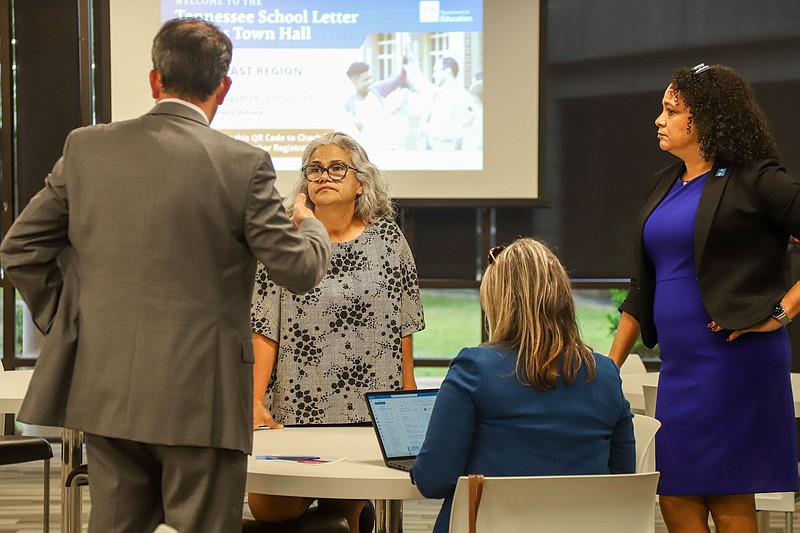After five years of delays, the Tennessee Department of Education has outlined how the state will grade schools on an A to F scale Thursday.
The letter grades, required by a Tennessee law passed in 2016, were first supposed to be assigned in 2018, but online testing problems followed by pandemic-related disruptions caused the state to repeatedly push back its rollout date. The new grades are expected to be released in mid-December with the annual Tennessee Department of Education report card.
As required by law, the newly released letter grade model considers academic proficiency and student growth. It also weighs the growth of the lowest-performing quartile of students, who are identified based on the previous year's Tennessee Comprehensive Assessment Program.
For high schools, the model also considers college and career readiness, which is calculated through the percent of a graduating cohort that achieves one of several conditions. These include a qualifying score on one of several standardized tests — such as the ACT, Advanced Placement, International Baccalaureate, dual enrollment or Armed Services Vocational Aptitude Battery — as well as earning either a Tier III industry credential or a Tier II plus one other industry credential.
Shannon Moody, chief strategy officer at Hamilton County Schools, said she was happy to see growth and achievement weighted almost equally in the model and called the focus on the lowest performing 25% of students an important measure.
School letter grade weights and indicators
Elementary and Middle School
— Achievement: 50%
— Growth: 40%
— Growth of lowest-performing students: 10%
High School
— Achievement: 50%
— Growth: 30%
— Growth of lowest-performing students: 10%
— College and Career Readiness: 10%
Source: Tennessee Department of Education
"It's always been a very important story for us to tell both achievement and growth. We believe, and we hold true to this belief, that student performance is both," she said in a phone interview, adding that residents "always hear us talking about the balance between achievement and growth, and that's going to be reflected in the scores of what they see for their schools."
(READ MORE: Tennessee to issue letter grades to schools this fall, leaders consider public input)
In the lead-up to the state's release, much of the discussion at town halls, working group sessions and in public comments focused on the long-standing debate comparing proficiency and growth as measures of student achievement. Proficiency looks at the number of students who met state standards, while growth examines how much students learned compared to where they started.
A previous accountability model that was never used to issue letter grades offered two pathways for schools to demonstrate achievement. The first, called "pure achievement," focused on the percent of students who demonstrate proficiency, while the other looked at whether schools met their annual measurable objectives, a yearly target for improving performance based on prior year results.
The new model exclusively uses pure achievement, something Tennessee Department of Education Commissioner Lizzette Gonzalez Reynolds has advocated for.
"It's about achievement and there's no best of," she told members of the state Board of Education on Thursday. "You either achieve or you don't."
Later, in response to a board member's question about the perception that high-poverty schools will not be able to get a top letter grade even though they have large growth rates, Reynolds said she thought it was "an unfortunate expectation."
Moody said it felt like a missed opportunity for the state to not reflect schools' success at meeting annual targets in the letter grades.
(READ MORE: Hamilton County Schools earns top academic growth score, plans to improve math scores)
Proponents of the growth pathway for demonstrating achievement say a formula that's weighted too heavily toward pure achievement could produce grades that are correlated with each school's income level, rather than demonstrate what is happening within individual schools. Scatterplots on the Tennessee Value-Added Assessment System website show a correlation between achievement and the percent of a school's students who are economically disadvantaged but no correlation between growth and income-level.
"We believe that high expectations come in the balance. There's a narrative out there that to have a balanced accountability system is to have low expectations for certain kids. I could not disagree more," Hamilton County Schools Deputy Superintendent Sonia Stewart said in an interview ahead of the state's release.
"This balanced approach is in fact setting what we think to be the highest expectations, and it's also believing in the kids and the families that are in our schools that when we partner together well, we will grow together and grow faster," she said.
The grades could also have consequences. Officials representing schools that get a D or F may face audits or hearings before the state Board of Education, starting with the 2024-25 school year.
"We're not going to go in there and take away their money or slap them around," Reynolds said. "The public will know how they're doing with their kids. So at the end of the day, it's got to be about the kids."
Department officials said the model will likely be adjusted over time.
"I do think that as a society, we're at a place where we are willing to criticize public education in ways that could in fact ultimately dismantle public education," Stewart said. "I think there's some things to think about there with why we do what we do."
Contact Shannon Coan at scoan@timesfreepress.com or 423-757-6396.
